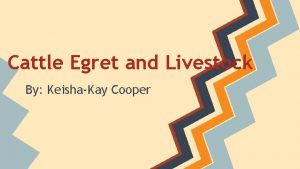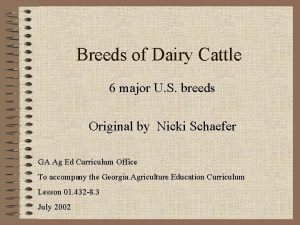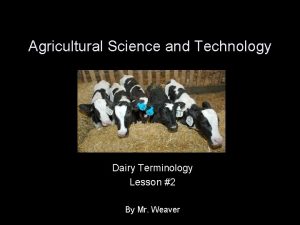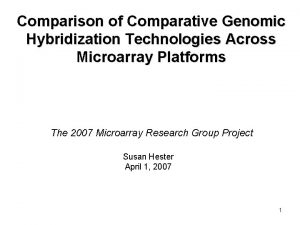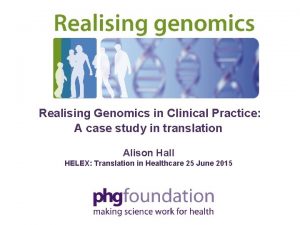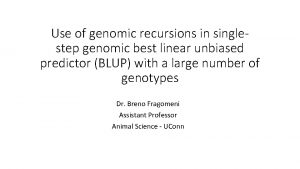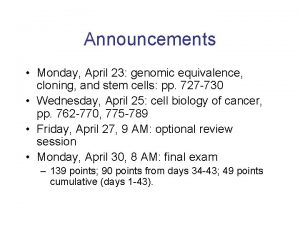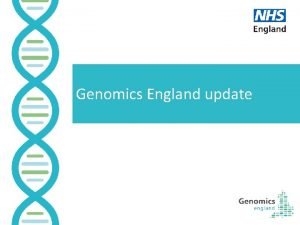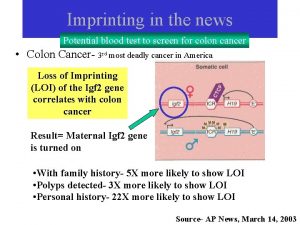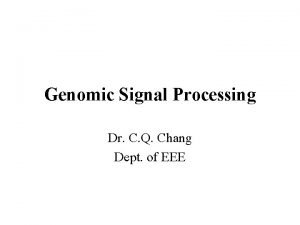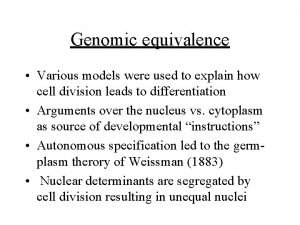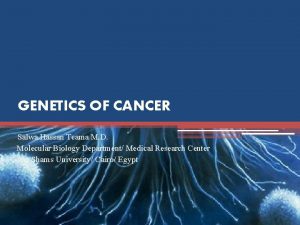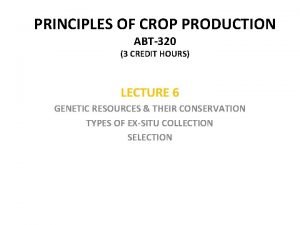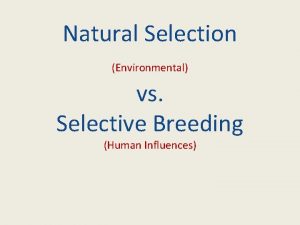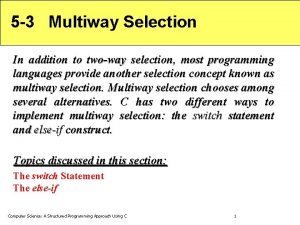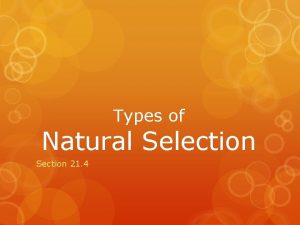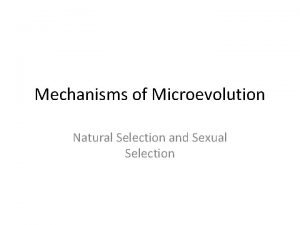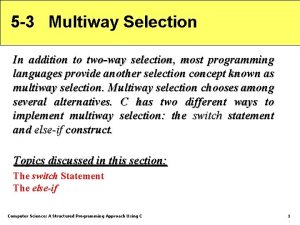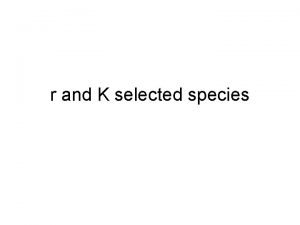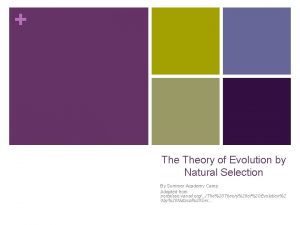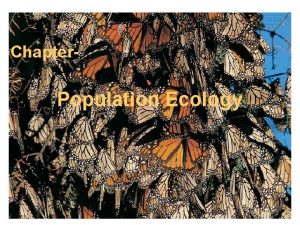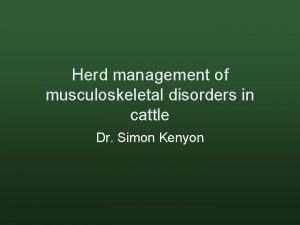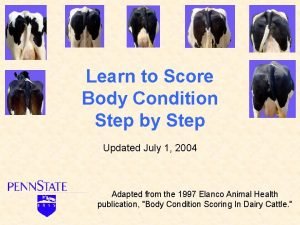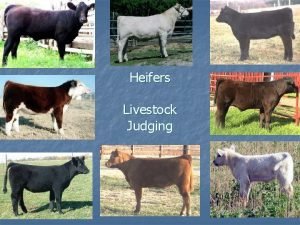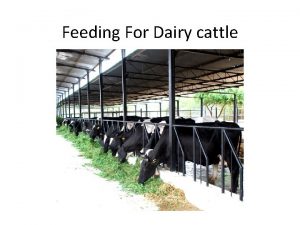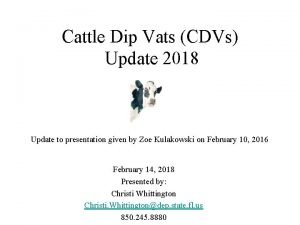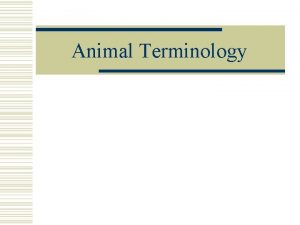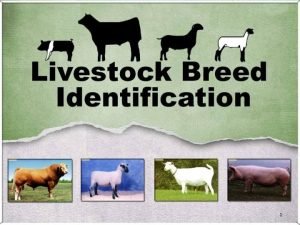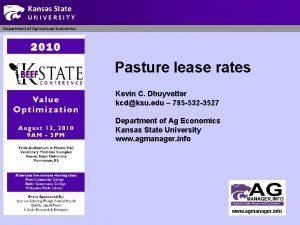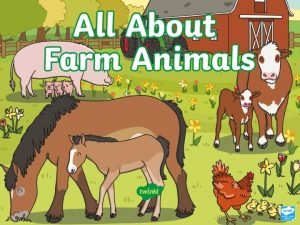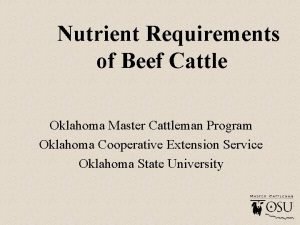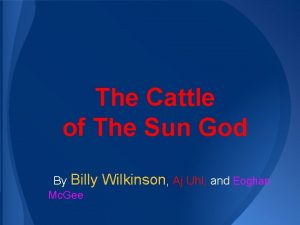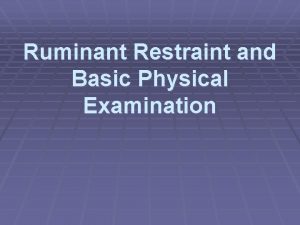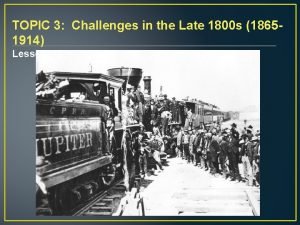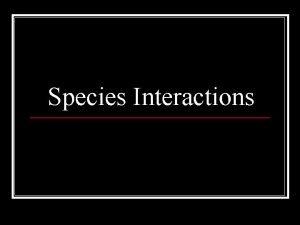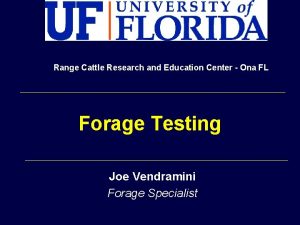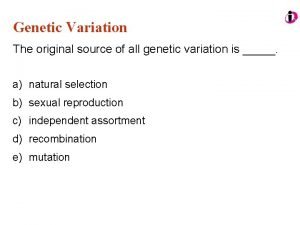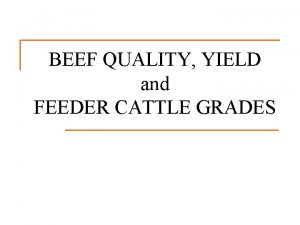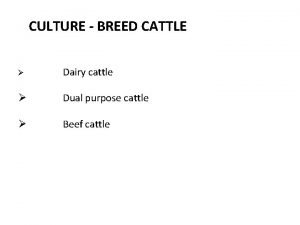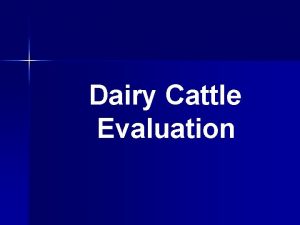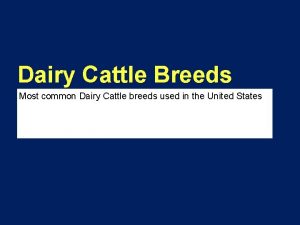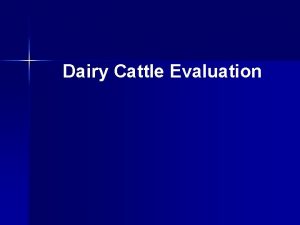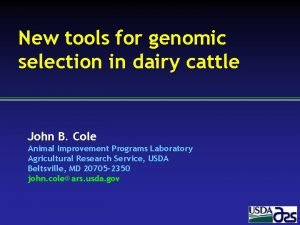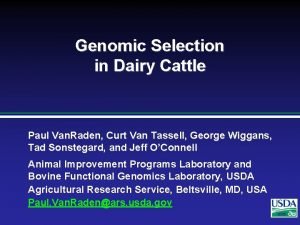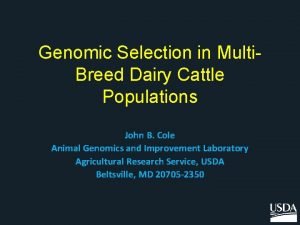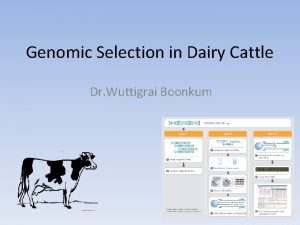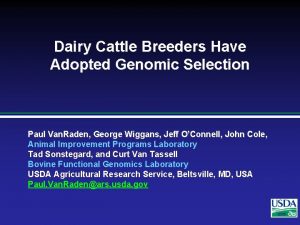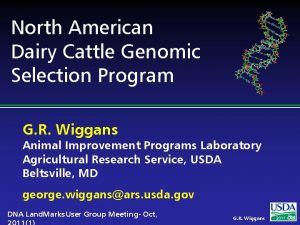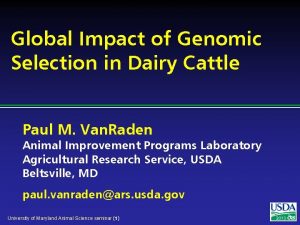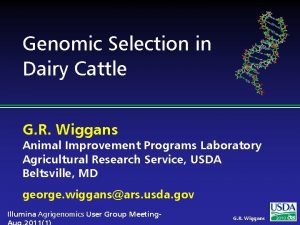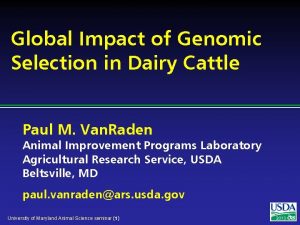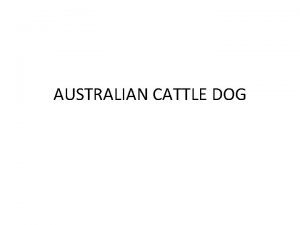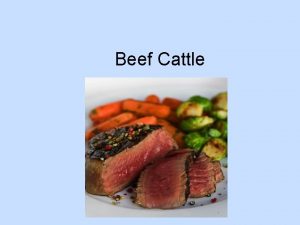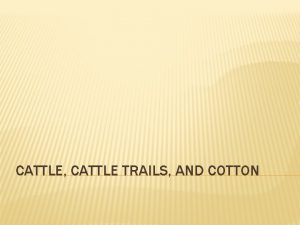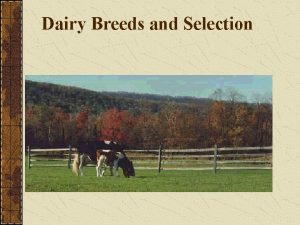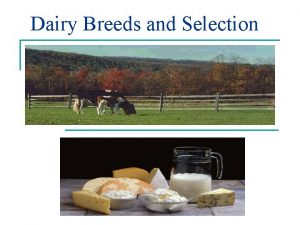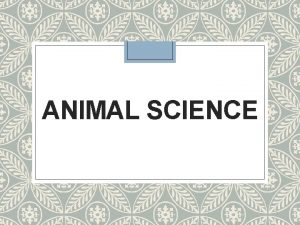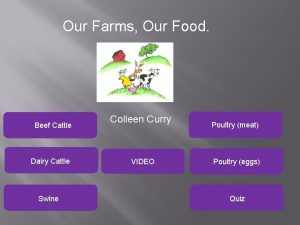Application of Genomic Selection in Dairy Cattle G











































- Slides: 43

Application of Genomic Selection in Dairy Cattle G. R. Wiggans Animal Improvement Programs Laboratory Agricultural Research Service, USDA Beltsville, MD george. wiggans@ars. usda. gov Cornell Department of Plant Breeding and G. R. Wiggans 2011

Dairy Cattle l 9 million cows in US l Attempt to have a calf born every year l Replaced after 2 or 3 years of milking l Bred via AI l Bull semen collected several times/week. Diluted and frozen l Popular bulls have 10, 000+ progeny l Cows can have many progeny though super ovulation and embryo transfer Cornell Department of Plant Breeding and G. R. Wiggans 2011

Data Collection l Monthly recording w Milk yields w Fat and Protein percentages w Somatic Cell Count (Mastitis indicator) l Visual appraisal for type traits l Breed Associations record pedigree l Calving difficulty and Stillbirth Cornell Department of Plant Breeding and G. R. Wiggans 2011

Traditional evaluations 3 X/year l Yield w l Type w l Stature, Udder characteristics, feet and legs Calving w l Milk, Fat, Protein Calving Ease, Stillbirth Functional w Somatic Cell, Productive Life, Fertility Cornell Department of Plant Breeding and G. R. Wiggans 2011

Use of evaluations l Bulls to sell semen from l Parents of next generation of bulls l Cows for embryo donation Cornell Department of Plant Breeding and G. R. Wiggans 2011

Lifecycle of bull Parents Selected Dam Inseminated Embryo Transferred to Recipient Bull Born Genomic Test Semen collected (1 yr) Daughters Born (9 m later) Daughters have calves (2 yr later) Cornell Department of Plant Breeding and Bull Receives Progeny Test (5 yrs) G. R. Wiggans 2011

Benefit of genomics l Determine value of bull at birth l Increase accuracy of selection l Reduce generation interval l Increase selection intensity l Increase rate of genetic gain Cornell Department of Plant Breeding and G. R. Wiggans 2011

History of genomic evaluations l Dec. 2007 Bovine. SNP 50 Bead. Chip available l Apr. 2008 First unofficial evaluation released l Jan. 2009 Genomic evaluations official for Holstein and Jersey l Aug. 2009 Official for Brown Swiss l Sept. 2010 Unofficial evaluations from 3 K chip released l Dec. 2010 3 K genomic evaluations to be official l Sept. 2011 Infinium Bovine. LD Bead. Chip available Cornell Department of Plant Breeding and G. R. Wiggans 2011

Cattle SNP Collaboration -i. BMAC l Develop 60, 000 Bead Illumina i. Select® assay USDA-ARS Beltsville Agricultural Research Center: Bovine Functional Genomics Laboratory and Animal Improvement Programs Laboratory w University of Missouri w University of Alberta w USDA-ARS US Meat Animal Research Center Started w/ 60, 800 beads – 54, 000 useable SNP w l Cornell Department of Plant Breeding and G. R. Wiggans 2011

Participants i. BMAC Consortium § § § Funding Agencies Illumina § Marylinn Munson § Cindy Lawley § Christian Haudenschild BARC § Curt Van Tassell § Lakshmi Matukumalli § Tad Sonstegard Missouri § Jerry Taylor § Bob Schnabel § Stephanie Mc. Kay Alberta § Steve Moore USMARC – Clay Center § Tim Smith § Mark Allan Cornell Department of Plant Breeding and § USDA/NRI/CSREES § 2006 -35616 -16697 § 2006 -35205 -16888 § 2006 -35205 -16701 § USDA/ARS § 1265 -31000 -081 D § 1265 -31000 -090 D § 5438 -31000 -073 D § Merial § Stewart Bauck § NAAB § § § § Godon Doak ABS Global Accelerated Genetics Alta Genetics CRI/Genex Select Sires Semex Alliance Taurus Service G. R. Wiggans 2011

Chips l l l Bovine. SNP 50 w Version 1 54, 001 SNP w Version 2 54, 609 SNP w 45, 187 used in evaluations 50 KV 2 HD LD HD w 777, 962 SNP w Only 50 K SNP used, w >1700 in database LD w 6, 909 SNP w Replaced 3 K Cornell Department of Plant Breeding and G. R. Wiggans 2011

Use of HD l l Currently only 50 K subset of SNP used Some increase in accuracy from better tracking of QTL possible Potential for across breed evaluations Requires few new HD genotypes once adequate base for imputation developed Cornell Department of Plant Breeding and G. R. Wiggans 2011

LD chip l l 6909 SNP mostly from SNP 50 chip w 9 Y Chr SNP included for sex validation w 13 Mitochondrial DNA SNP w Evenly spaced across 30 Chr (increased density at ends) Developed to address performance issues with 3 K while continuing to provide low cost genotyping l Provides over 98% accuracy imputing 50 K genotypes l Included beginning with Nov genomic evaluation Cornell Department of Plant Breeding and G. R. Wiggans 2011

Development of LD chip l l Consortium included researchers from USA, AUS and FRA Objective: good imputation performance in dairy breeds w Uniform distribution except heavier at chromosome ends w High MAF, avg MAF over 30% for most breeds w Adequate overlap with 3 K Cornell Department of Plant Breeding and G. R. Wiggans 2011

Genomic evaluation program steps l Identify animals to genotype l Sample to lab l Genotype sample l Genotype to USDA l Calculate genomic evaluation l Release monthly Cornell Department of Plant Breeding and G. R. Wiggans 2011

Responsibilities of requester l l l Insure animal is properly identifiedeg HOCANF 000123456789 Enroll animal with breed association or insure pedigree on animal and dam reaches AIPL Collect clean, clearly labeled DNA sample Get sample to lab in time to be included in desired month’s results Resolve parentage conflicts quickly Cornell Department of Plant Breeding and G. R. Wiggans 2011

Steps to prepare genotypes l Nominate animal for genotyping l Collect blood, hair, semen, nasal swab, or ear punch w Blood may not be suitable for twins l Extract DNA at laboratory l Prepare DNA and apply to. Bead. Chip l Do amplification and hybridization, 3 -day process l Read red/green intensities from chip and call genotypes from clusters Cornell Department of Plant Breeding and G. R. Wiggans 2011

What can go wrong l l l Sample does not provide adequate DNA quality or quantity Genotype has many SNP that can not be determined (90% call rate required) Parent-progeny conflicts w Pedigree error w Sample ID error (Switched samples) w Laboratory error w Parent-progeny relationship detected that is not in pedigree Cornell Department of Plant Breeding and G. R. Wiggans 2011

Lab QC l Each SNP evaluated for w Call Rate w Portion Heterozygous w Parent-progeny conflicts l Clustering investigated if SNP exceeds limits l Number of failing SNP is indicator of genotype quality l Target fewer than 10 SNP in each category Cornell Department of Plant Breeding and G. R. Wiggans 2011

Before clustering adjustment 86% call rate Cornell Department of Plant Breeding and G. R. Wiggans 2011

After clustering adjustment 100% call rate Cornell Department of Plant Breeding and G. R. Wiggans 2011

Parentage validation and discovery l Parent-progeny conflicts detected Animal checked against all other genotypes w Reported to breeds and requesters w Correct sire usually detected w l Maternal Grandsire checking SNP at a time checking w Haplotype checking more accurate w l Breeds moving to accept SNP in place of microsatellites Cornell Department of Plant Breeding and G. R. Wiggans 2011

Checking facility l l Labs place genotype files on AIPL server Genotypes run through analysis procedures, but not added to database Reports on missing nominations and QC data returned to Lab can Detect sample misidentification w Improve clustering w Apply the same checks used by AIPL w Cornell Department of Plant Breeding and G. R. Wiggans 2011

Imputation l l Based on splitting the genotype into individual chromosomes (maternal & paternal contributions) Missing SNP assigned by tracking inheritance from ancestors and descendents Imputed dams increase predictor population 3 K, LD, & 50 K genotypes merged by imputing SNP not on LD or 3 K Cornell Department of Plant Breeding and G. R. Wiggans 2011

Recessive defect discovery l Check for homozygoushaplotypes l Most haplotype blocks ~5 Mbp long l 7 – 90 expected, but 0 observed l 5 of top 11 haplotypes confirmed as lethal l Investigation of 936 – 52, 449 carrier sire carrier MGS fertility records found 3. 0 – 3. 7% lower conception rates Cornell Department of Plant Breeding and G. R. Wiggans 2011

Haplotypes impacting fertility Breed BTA chromosome Location, Mbases Holstein 5 62– 68 4. 5 1 93– 98 4. 6 8 92– 97 4. 7 Jersey 15 11– 16 23. 4 Brown Swiss 7 42– 47 14. 0 Cornell Department of Plant Breeding and Carrier frequency, % G. R. Wiggans 2011

Data and evaluation flow Requester (Ex: AI, breeds) mp sa no les ev mi na alu tio ns ati on s Genomic Evaluation Lab Dairy producers samples sa es mp les p oty n ge DNA laboratories Cornell Department of Plant Breeding and G. R. Wiggans 2011

Collaboration l Full sharing of genotypes with Canada w l Trading of Brown Swiss genotypes with Switzerland, Germany, and Austria w l CDN calculates genomic evaluations on Canadian base Interbull may facilitate sharing Agreements with Italy and Great Britain provide genotypes for Holstein w Negotiations underway with other countries Cornell Department of Plant Breeding and G. R. Wiggans 2011

Number of New Genotypes 6000 5000 4000 3000 2000 1000 0 09/10 11/10 01/11 03/11 50 K and HD Cornell Department of Plant Breeding and 05/11 07/11 09/11 11/11 3 K and LD G. R. Wiggans 2011

Genotyped Holsteins Date 04 -10 08 -10 12 -10 04 -11 05 -11 06 -11 07 -11 08 -11 09 -11 10 -11 11 -11 12 -11 Bulls* 9, 770 10, 430 11, 293 12, 152 12, 429 15, 379 15, 386 16, 519 16, 812 16, 834 17, 288 Cows* 7, 415 9, 372 12, 825 11, 224 11, 834 12, 098 12, 219 14, 380 14, 415 14, 573 14, 716 17, 236 Young animals** Bulls Heifers 16, 007 8, 630 18, 652 11, 021 21, 161 18, 336 25, 202 36, 545 26, 139 40, 996 27, 508 45, 632 28, 456 50, 179 29, 090 52, 053 30, 185 56, 559 31, 865 61, 045 32, 975 65, 330 33, 861 68, 051 All animals 41, 822 49, 475 63, 615 85, 123 91, 398 100, 617 106, 240 112, 042 117, 971 124, 315 129, 855 136, 436 *Traditional evaluation **No traditional evaluation Cornell Department of Plant Breeding and G. R. Wiggans 2011

Sex Distribution August 2010 November 2011 Females 39% Males 38% Males 61% Females 62% All genotypes Cornell Department of Plant Breeding and G. R. Wiggans 2011

Calculation of genomic evaluations l l l Deregressed values derived from traditional evaluations of predictor animals Allele substitutions random effects estimated for 45, 187 SNP Polygenic effect estimated for genetic variation not captured by SNP Selection Index combination of genomic and traditional not included in genomic Applied to yield, fitness, calving and type traits Cornell Department of Plant Breeding and G. R. Wiggans 2011

Holstein prediction accuracy Traita Biasb b REL (%) REL gain (%) Milk (kg) − 64. 3 0. 92 67. 1 28. 6 Fat (kg) − 2. 7 0. 91 69. 8 31. 3 Protein (kg) 0. 7 0. 85 61. 5 23. 0 Fat (%) 0. 0 1. 00 86. 5 48. 0 Protein (%) 0. 0 0. 90 79. 0 40. 4 − 1. 8 0. 98 53. 0 21. 8 SCS 0. 0 0. 88 61. 2 27. 0 DPR (%) 0. 0 0. 92 51. 2 21. 7 Sire CE 0. 8 0. 73 31. 0 10. 4 − 1. 1 0. 81 38. 4 19. 9 1. 5 0. 92 21. 8 3. 7 − 0. 2 0. 83 30. 3 13. 2 PL (months) Daughter CE Sire SB Daughter SB a PL=productive life, CE = calving ease and SB = stillbirth. b 2011 deregressed value – 2007 genomic evaluation. Cornell Department of Plant Breeding and G. R. Wiggans 2011

Reliabilities for young Holsteins* Number of animals 9000 50 K genotypes 8000 3 K genotypes 7000 6000 5000 4000 3000 2000 1000 0 40 45 50 55 60 65 70 75 80 Reliability for PTA protein (%) *Animals with no traditional PTA in April 2011 Cornell Department of Plant Breeding and G. R. Wiggans 2011

Holstein Protein SNP Effects Cornell Department of Plant Breeding and G. R. Wiggans 2011

Use of genomic evaluations l Determine which young bulls to bring into AI service l Use to select mating sires l Pick bull dams l Market semen from 2 -year-old bulls Cornell Department of Plant Breeding and G. R. Wiggans 2011

Use of LD genomic evaluations l Sort heifers for breeding w Flush w Sexed semen w Beef bull l Confirm parentage to avoid inbreeding l Predict inbreeding depression better l Precision mating considering genomics(future) Cornell Department of Plant Breeding and G. R. Wiggans 2011

Ways to increase accuracy l l Automatic addition of traditional evaluations of genotyped bulls when reach 5 years of age Possible genotyping of 10, 000 bulls with semen in repository l Collaboration with more countries l Use of more SNP from HD chips l Full sequencing – Identify causative mutations Cornell Department of Plant Breeding and G. R. Wiggans 2011

Application to more traits l l l Animal’s genotype is good for all traits Traditional evaluations required for accurate estimates of SNP effects Traditional evaluations not currently available for heat tolerance or feed efficiency Research populations could provide data for traits that are expensive to measure Will resulting evaluations work in target population? Cornell Department of Plant Breeding and G. R. Wiggans 2011

Impact on producers l l l Young-bull evaluations with accuracy of early 1 st crop evaluations AI organizations marketinggenomically evaluated 2 year-olds Genotype usually required for cow to be bull dam Rate of genetic improvement likely to increase by up to 50% Studs reducing progeny-test programs Cornell Department of Plant Breeding and G. R. Wiggans 2011

Why Genomics works in Dairy l Extensive historical data available l Well developed genetic evaluation program l Widespread use of AI sires l Progeny test programs l High valued animals, worth the cost of genotyping l Long generation interval which can be reduced substantially by genomics Cornell Department of Plant Breeding and G. R. Wiggans 2011

Summary l l l Extraordinarily rapid implementation of genomic evaluations Chips provide genotypes of high accuracy Comprehensive checking insures quality of genotypes stored Young-bull acquisition and marketing now based on genomic evaluations Genotyping of many females because of lower cost low density chips Cornell Department of Plant Breeding and G. R. Wiggans 2011

Cornell Department of Plant Breeding and G. R. Wiggans 2011
 Cattle egret and cattle symbiotic relationship
Cattle egret and cattle symbiotic relationship 6 breeds of dairy cattle
6 breeds of dairy cattle Dairy cattle terminology
Dairy cattle terminology Comparative genomic hybridization animation
Comparative genomic hybridization animation Genomic england
Genomic england Genomic
Genomic Genomic equivalence definition
Genomic equivalence definition Genomic england
Genomic england Genomic imprinting definition
Genomic imprinting definition Genomic england
Genomic england Genomic signal processing
Genomic signal processing Genomic equivalence
Genomic equivalence Genomic instability
Genomic instability Procedure of pure line selection
Procedure of pure line selection Natural selection vs artificial selection
Natural selection vs artificial selection Natural selection vs artificial selection
Natural selection vs artificial selection Artificial selection vs natural selection
Artificial selection vs natural selection Two way selection and multiway selection
Two way selection and multiway selection Balancing selection vs stabilizing selection
Balancing selection vs stabilizing selection Example of stabilizing selection
Example of stabilizing selection Multiway selection in c
Multiway selection in c K selected
K selected Similarities
Similarities Clumped dispersion
Clumped dispersion Laminitis in cattle
Laminitis in cattle Frame score cattle
Frame score cattle Hooks and pins cattle
Hooks and pins cattle Beef cattle judging practice
Beef cattle judging practice Cattle feed products
Cattle feed products Cattle dip vat
Cattle dip vat Mature male cattle
Mature male cattle Simbrah origin
Simbrah origin Pasture rent for cattle in kansas
Pasture rent for cattle in kansas A cow give us
A cow give us Nutritional requirements for beef cattle
Nutritional requirements for beef cattle Master cattleman program
Master cattleman program Cattle of the sun god
Cattle of the sun god Burley method of casting
Burley method of casting What contribution did mexicans make to cattle ranching?
What contribution did mexicans make to cattle ranching? 5 major types of species interactions
5 major types of species interactions Range cattle research and education center
Range cattle research and education center Components of genetic variation
Components of genetic variation Yield grade chart
Yield grade chart Dada
Dada
